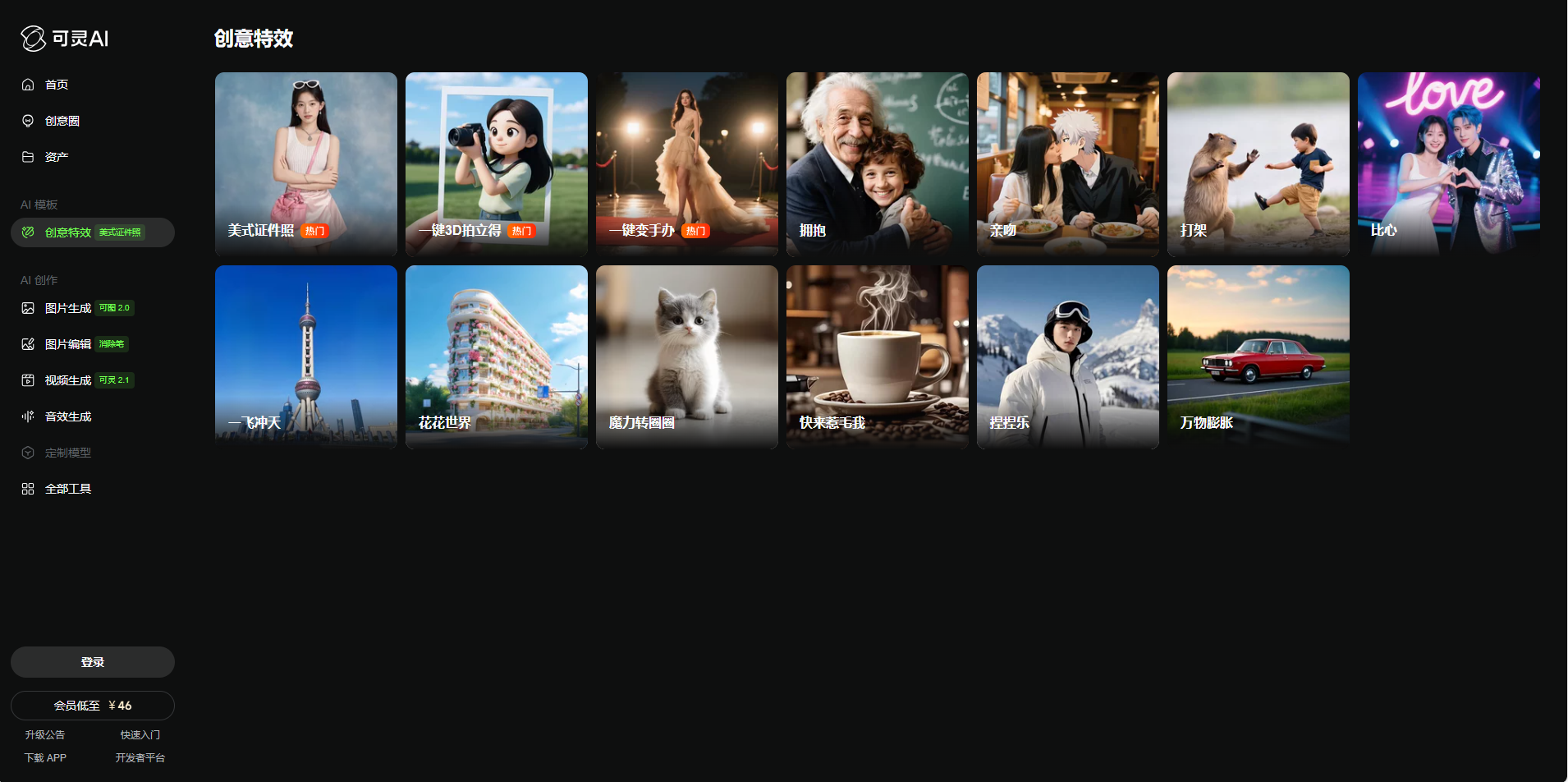记一次AI拍立得视频生成实践
近日,笔者受辅导员委托,为校宣传部开发一个官方的小程序平台,实现毕业生AI人像视频生成。效果模仿可灵AI的一键3D拍立得。尽管后来由于某些原因中止了,但实践过程中还是有趣的。

这个效果初看容易,实际上仅调用图生视频API无法直接得到很好的效果,并且不能精准地控制标尺和缩放效果。
笔者经过仔细观察,发现这个视频其实是由 前2秒的模板 + 后5秒的AI视频 组成。
开发过程
开发步骤
首先确定思路,该任务在视频实现方面有三个重要步骤。
- 上传毕业照,生成可爱风格的人像照片。
- 生成前2秒的效果:有一个弧形的标尺,左右旋转分别对应缩放效果。由于对于不同照片这个效果都是一致的,因此需要通过视频模板生成。
- 生成后5秒的AI效果:基于(1)中的可爱人像,调用图生视频API,用提示词引导模型得到灵动的效果。
由于API一般都用Python调用比较方便,采用Flask框架快速开发。
开发难点
经过简单的实践,(2)和(3)均可调用API完成,(1)却没有找到很好的方法。
最终,笔者采用一种个性化的定制方案:利用OpenCV绘制视频。
安装OpenCV
1
|
pip install opencv-python
|
1
2
3
4
5
6
7
8
9
10
11
12
13
14
15
16
17
18
19
20
21
22
23
24
25
26
27
28
29
30
31
32
33
34
35
36
37
38
39
40
41
42
|
def draw_circle_ruler(frame, center, max_radius, angle, ruler_alpha):
# 绘制刻度线
for i in range(0, 360, 10):
# 计算刻度线位置
rad = math.radians(i + angle)
inner_radius = int(max_radius * 0.9)
outer_radius = max_radius
# 主刻度(每30度)
if i % 30 == 0:
outer_radius += 10
thickness = 3
color = (255, 255, 255)
# 添加数字
text_radius = int(max_radius * 0.85)
text_pos = (
int(center[0] + text_radius * math.sin(rad)),
int(center[1] - text_radius * math.cos(rad))
)
cv2.putText(frame, str(i // 10), text_pos,
cv2.FONT_HERSHEY_SIMPLEX, 2, color, 3)
else:
thickness = 1
color = (255, 255, 255)
start_point = (
int(center[0] + inner_radius * math.sin(rad)),
int(center[1] - inner_radius * math.cos(rad))
)
end_point = (
int(center[0] + outer_radius * math.sin(rad)),
int(center[1] - outer_radius * math.cos(rad))
)
cv2.line(frame, start_point, end_point, color, thickness)
# 添加透明度效果
if ruler_alpha < 1.0:
overlay = frame.copy()
cv2.circle(overlay, center, max_radius + 20, (0, 0, 0), -1)
frame = cv2.addWeighted(overlay, 1 - ruler_alpha, frame, ruler_alpha, 0)
return frame
|
1
2
3
4
5
6
7
8
9
10
11
12
13
14
15
16
17
18
19
20
21
22
23
24
25
26
27
28
29
30
|
def draw_camera_icon(frame, button_pos):
# 添加底部录制按钮
button_radius = 160
button_thickness = 15 # 外圆厚度
corner_radius = 10 # 圆角半径
square_size = 60
# 绘制白色外圆(有一定厚度)
cv2.circle(frame, button_pos, button_radius, (255, 255, 255), button_thickness)
# 绘制红色圆角正方形
top_left = (button_pos[0] - square_size, button_pos[1] - square_size)
bottom_right = (button_pos[0] + square_size, button_pos[1] + square_size)
# 创建圆角矩形的轮廓
rect = np.array([
[top_left[0] + corner_radius, top_left[1]], # 上边开始
[bottom_right[0] - corner_radius, top_left[1]], # 上边结束
[bottom_right[0], top_left[1] + corner_radius], # 右上角
[bottom_right[0], bottom_right[1] - corner_radius], # 右边结束
[bottom_right[0] - corner_radius, bottom_right[1]], # 右下角
[top_left[0] + corner_radius, bottom_right[1]], # 下边结束
[top_left[0], bottom_right[1] - corner_radius], # 左下角
[top_left[0], top_left[1] + corner_radius] # 左边结束
], dtype=np.int32)
# 绘制填充的圆角矩形
cv2.fillPoly(frame, [rect], (0, 0, 255))
return frame
|
1
2
3
4
5
6
7
8
9
10
11
12
13
14
15
16
17
18
19
20
21
22
23
24
25
26
27
28
29
30
31
32
33
34
35
36
37
38
39
40
41
42
43
|
for frame_num in range(total_frames):
# 计算当前进度(0-1)
progress = frame_num / total_frames
# 创建当前帧的副本
frame = img.copy()
# 计算当前标尺的显示比例(0-1)
ruler_alpha = min(0.3, progress * 2) # 前50%的时间完成显示
if ruler_alpha > 0:
frame = draw_circle_ruler(frame, center, max_radius, angle, ruler_alpha) # 绘制圆形标尺
# 计算当前旋转角度(-30到30度之间摆动)
if progress < 0.5:
# 计算当前缩放比例(0.8-1.2之间变化)
last_scale = scale
last_angle = angle
scale = 1.0 + 0.2 * math.sin(progress * math.pi) # 2个完整周期
angle = -30 * math.sin(progress * math.pi) # 2个完整周期
else:
scale = last_scale
angle = last_angle
# 应用缩放
if scale != 1.0:
M = cv2.getRotationMatrix2D(original_center, 0, scale)
frame = cv2.warpAffine(frame, M, (w, h))
button_pos = (w // 2, h - 300)
""" 写一下其他按钮的绘制逻辑 """
# 显示或写入帧
if output_path:
out.write(frame)
else:
# 保持原始宽高比例显示
cv2.namedWindow('Ruler Animation', cv2.WINDOW_NORMAL)
cv2.resizeWindow('Ruler Animation', w, h) # 设置为原始图片尺寸
cv2.imshow('Ruler Animation', frame)
if cv2.waitKey(30) & 0xFF == ord('q'):
break
|
这样就完成了前两秒的视频绘制。
图像和视频的生成调用API即可,不再赘述。推荐可灵AI的API和阿里的通义万相。
下面讲述如何将两段视频拼接,并自动添加转场。
下载ffmpeg库,用subprocess运行命令行实现。
1
2
3
4
5
6
7
8
9
10
11
12
13
14
15
16
17
18
19
20
21
22
23
24
25
26
27
28
29
30
31
32
33
|
def combine_video(input_video1, input_video2, output_video):
# 构建FFmpeg命令
ffmpeg_cmd = [
"ffmpeg",
"-i", input_video1,
"-i", input_video2,
"-filter_complex",
"[0:v]scale=1920:1080:force_original_aspect_ratio=decrease,"
"pad=1920:1080:(ow-iw)/2:(oh-ih)/2,"
"setsar=1:1," # 修复SAR不匹配
"fade=out:st=4:d=1[v1];"
"[1:v]scale=1920:1080:force_original_aspect_ratio=decrease,"
"pad=1920:1080:(ow-iw)/2:(oh-ih)/2,"
"setsar=1:1," # 修复SAR不匹配
"fade=in:st=0:d=1[v2];"
"[v1][v2]concat=n=2:v=1:a=0[outv]",
"-map", "[outv]",
"-c:v", "libx264",
"-preset", "fast",
"-crf", "23",
"-y", # 覆盖输出文件
output_video
]
# 运行命令
try:
subprocess.run(ffmpeg_cmd, check=True)
print("视频处理完成!")
except subprocess.CalledProcessError as e:
print(f"处理失败: {e}")
except FileNotFoundError:
print("错误: 找不到ffmpeg,请确保已安装FFmpeg并添加到系统PATH")
|
最后,我们就得到了2+5的可爱视频了!前两秒的视频模板完全可以自行定制,后面的效果则由Prompt工程调优。
总结
由于种种原因(费用开销、AI稳定性、人像隐私),最后这个项目没有继续,但也算是一次有趣的实践。
